ISSN ONLINE(2319-8753)PRINT(2347-6710)
ISSN ONLINE(2319-8753)PRINT(2347-6710)
Kotresh K.M 1, Anup.D.P2, Mesfin Getahun Belachew 3, Vageesh.H.P 4
|
| Related article at Pubmed, Scholar Google |
Visit for more related articles at International Journal of Innovative Research in Science, Engineering and Technology
At present the use of Ferrous Slag (FS) in concrete gives environmental and economic benefits for concerned industries, especially in places where a considerable amount of FS is produced. Owing to the scarcity of sand for the preparation of mortar as well as concrete, partial and fully replacement of FS with sand have been attempted. FS are by-products obtained during smelting and refining of FS. This work reports an experimental procedure to investigate the effect of using FS as partial replacement of sand. Six series of concrete mixtures were prepared with varies proportions of FS ranging from 0% to 100%. The test results of concrete were obtained by adding FS to sand in various percentages ranging from 0%, 20%. 40%, 60%, 80% and 100%. All specimens were cured for 7 & 28days before compression strength test etc. Results that workability increases with increase in percentage of FS and feasibility study on the use of broken Mangalore tiles as coarse aggregate in combination with iron ore slag in the production of low to medium strength concrete is carried out.
Keywords |
| Ferrous slag, Mangalore tiles, Iron ore dust, broken tiles. |
INTRODUCTION |
| In India and Ethiopia large number of industries which are usually producing ferrous slag as a waste every day. Use of FS in concrete provides some benefits for related industries. In our project we made use of Iron ore dust(slag) as a fine aggregate with complete replacement of sand. Iron ore dust can be defined as residue, tailing or waste material which is left after the extraction and processing of iron ore in the mines to form fine particles less than 4.75mm. Usually, Iron ore dust is treated as a complete waste, and used to fill the low lying areas. Use of Iron ore dust as an alternative to normal aggregates in concrete M. Nadeem et al [3] draws serious attention of researchers and investigators. And large quantity of construction waste as well as demolition waste such as paving blocks, tiles, timber, plastic, cardboards, metals and papers etc.. After extraction from other construction and demolition waste then sieved & used as a constituent for natural coarse aggregates (CAs) in concrete. In this study broken Mangalore tiles as coarse aggregate in addition with iron ore slag in the production of low to medium strength concrete is carried out. |
| Experimental Investigation |
| Objective |
| Important aspects of our thesis work is to strengthen the concrete with economical cost for structural applications with less aggregate content in it. |
| Main objectives are listed below |
| This investigation shows the suitability of using mangalore tiles and iron ore slag as replacement of aggregates in concrete. |
| Studying the behavior of concrete, replacing sand by iron ore slag in different replacement percentage to get optimum results and using it for M15 & M20 grade of concrete. Same done for coarse aggregate replacing mangalore tiles. |
| • Therefore, aim of this study to compare the mechanical properties of conventional concrete and proposed concrete. |
| • Comparing the cost analysis design of conventional concrete and proposed concrete with the respective grade of concrete |
| • Through this study, it is Commenting on the effect of Iron ore slag and mangalore tiles in concrete with respect to workability, compressive strength on concrete etc.. |
| Hence the possibility of using waste iron ore slag & tiles as an alternative construction material will be investigated. By conducting different tests on prepared specimens, it is intended to analyze the results. |
| Materials Used |
| The materials such as |
| Cement, |
| Sand, |
| Coarse Aggregate |
| Iron ore slag and Mangalore tiles. |
| The cement used for the present wok was ordinary Portland cement (Normal Portland cement). |
| Fine aggregate is of Zone-II as per Grading of aggregates IS: 383-1970 [5], Crushed aggregates are 20 mm graded aggregates as per Grading of aggregates IS: 383-1970 [5]. |
| The physical properties of aggregate were according to Indian Standard Specification IS: 10262(2009) [4]. |
| Iron ore dust (slag): |
| Iron ore is crushed and allowed to pass through various processes in the manufacture of iron in mines and in this process large volume of dust or fine particles of iron ore is generated. They are known as iron ore dust or iron ore slag. The slag obtained has properties similar to that of sand and can be used for construction purposes. Ayano T, Sakata K.(2000), [1] proposed a theory on concrete and this theory providesthe feasibility of the usage of iron ore dust as hundred percent substitutes for Conventional Concrete. Figure (a) Iron ore slag used in the present investigation. |
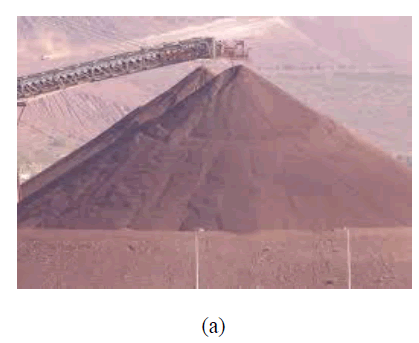 |
| Mangalore tile wastages |
| Mangalore was the birth place of tiles and the tiles were used all over India hence were known as Mangalore tiles. It was first introduced in India by a German missionary and these are fired clay tiles. The tiles produced by the factory were in great demand throughout the Indian subcontinent and East Africa Abundant deposits of clay. Hence broken tiles are available in plenty and free of cost, it becomes easy for the collection of our project. M .C. Nataraj et al [2] proposed a theory on concrete and this theory provides the feasibility of the usage of broken tiles as hundred percent substitutes for Conventional Concrete. |
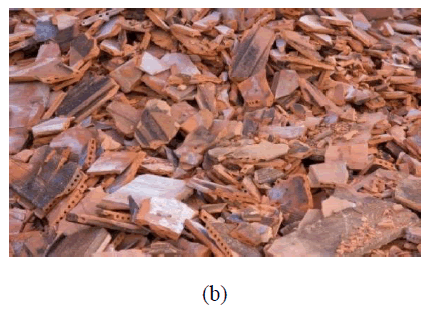 |
| Mix Proportion |
| In this investigation four type of mix is considered and designed as per Indian Standard Specification IS: 10262(2009) Water cement ratio- The ratio must be optimum according to the grade of concrete chosen and mix design has to be done |
| Quality aggregates – The quality of aggregates must be high. |
| The other three concrete mixes were made by replacing the fine aggregate & coarse aggregates with slag as well as tiles by weight respectively. |
EXPERIMENTAL PROGRAM |
| Workability aspect |
| The replacement of coarse aggregate by tiles and sand by iron ore slag effects on the workability of the concrete. The workability of this proposed concrete shows an increase in slump with increase of waste content of total aggregate volume. The result of the normal concrete mix showed an increase in workability, The results of the slump test are as shown Chart (c) slump test on design 1(m20) And similarly chart (d) shows slump test on design 1(m15) |
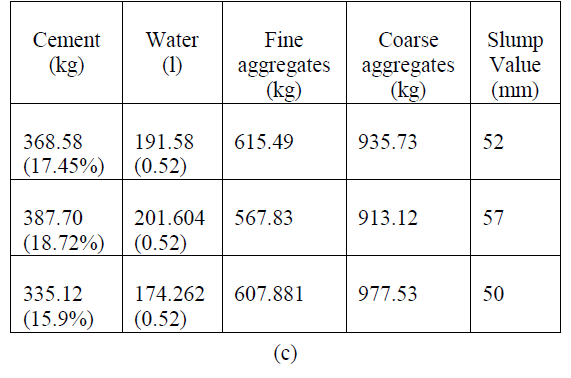 |
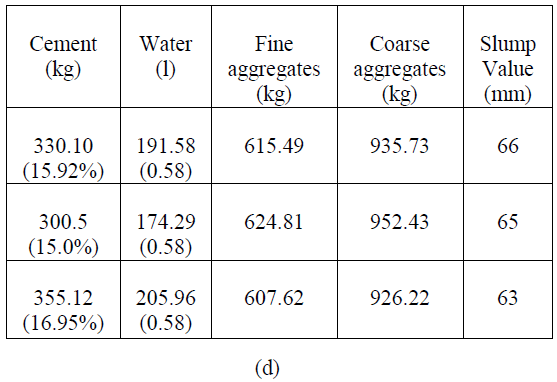 |
| Compressive Strength |
| Three cubes of same mix proportion. These are kept at a temperature of 27±2ºC for 24 hours. At the end of the period cubes are immersed in clean fresh water. The cubes are kept in water until time of testing. These cubes are tested for their compressive strength after 7 and 28 days curing in a compression testing machine, loading being uniform at the rate of 350 kg/cm²/minute. The load at failure is noted and compressive strength is calculated. for 7 days and 28 days are as follows. |
| Table (e) shows compressive strength test on m20 & table (f) shows compressive strength test on m15. |
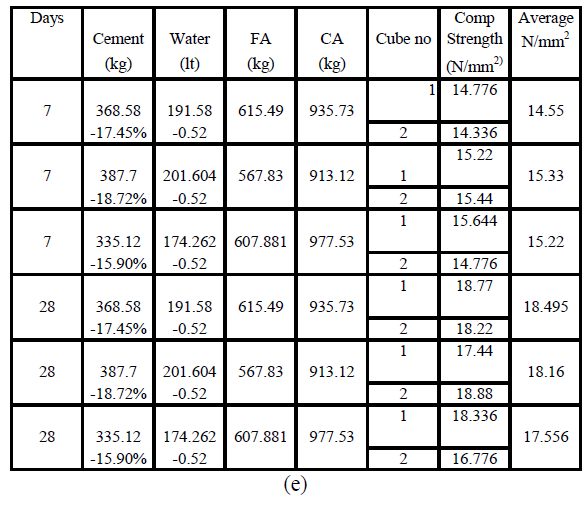 |
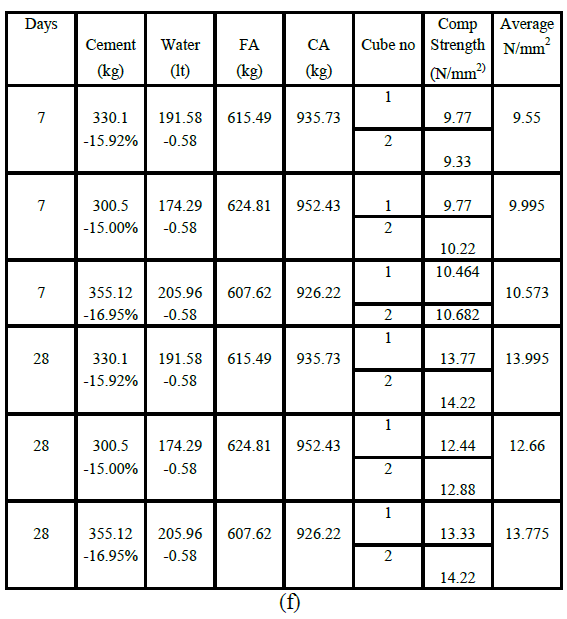 |
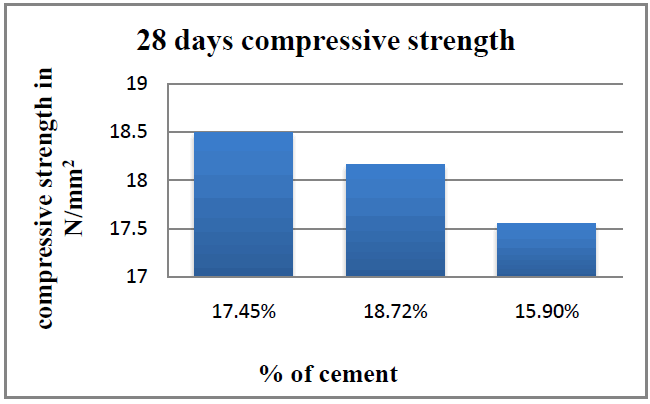 |
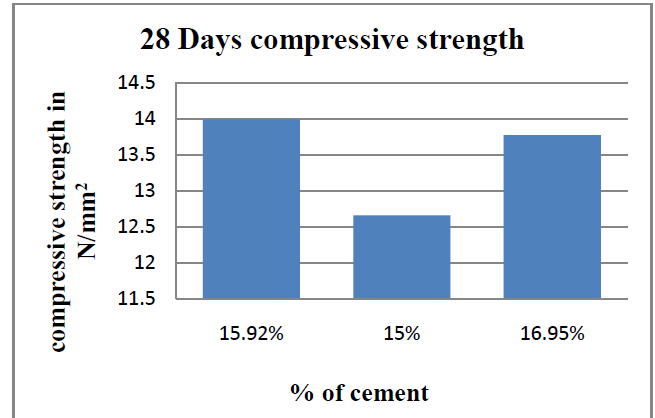 |
| Water absorption of concrete cubes |
| This test is performed to determine water absorption of quarry dust and broken Mangalore tile pieces. The moisture present in aggregate sample may be in the form of absorbed moisture or surface moisture or both. When all the pores in the aggregates are full and no water on the surface the aggregate are said to be saturated surface dry. If aggregate used for concrete are of this type they will not contribute any water to the cement paste and water cement ratio will remain same. Table (g) shows design1(m20) & Table (h) shows design1(m15). |
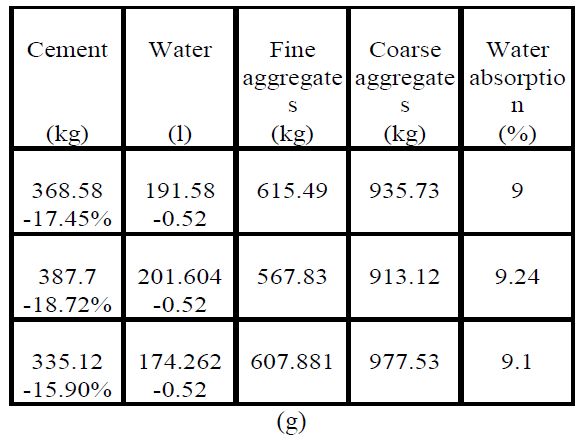 |
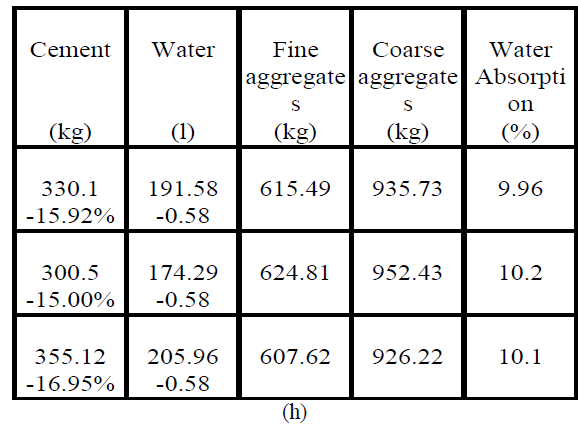 |
COST ANALYSIS |
| COST ANALYSIS (M20) |
| Conventional concrete: |
| Mix proportion: - 1: 1.739: 3.49 |
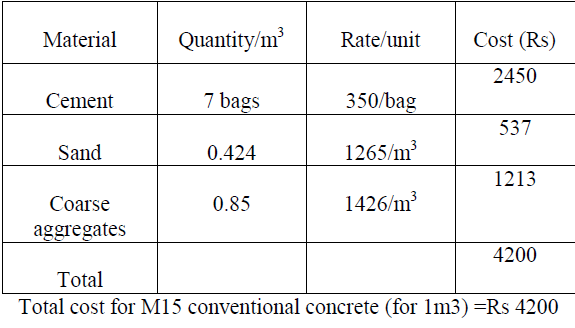 |
| Proposed concrete: |
| Mix proportion: - 1: 1.464: 2.35 |
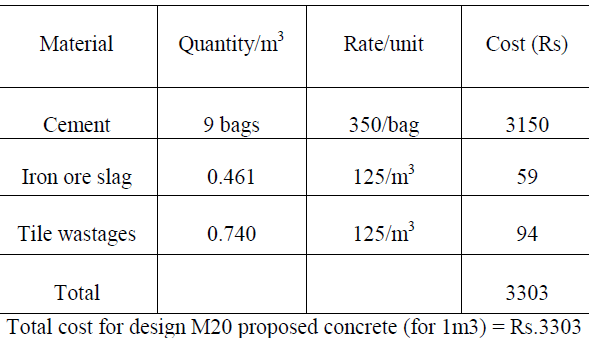 |
| Reduction in cost =21.35 % |
| COST ANALYSIS (M15) |
| Conventional concrete: |
| Mix proportion:-1: 1.933: 3.617 |
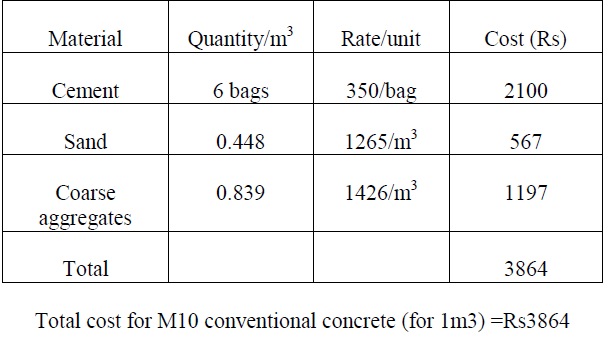 |
| Proposed concrete: |
| Mix proportion: - 1: 1.711: 2.608 |
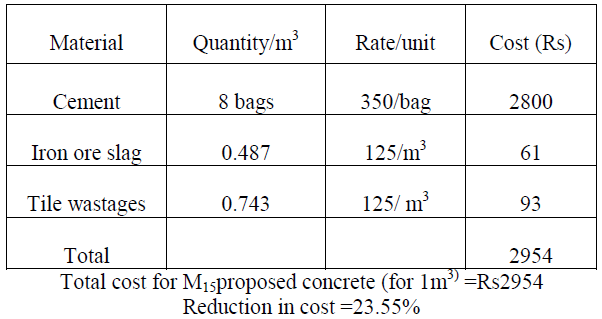 |
CONCLUSION |
| 1. The compressive strength of M20 concrete with Mangalore tiles as coarse aggregate was optimum with a value of 18.49 N/mm2 for a cement content of 368.58 kg/m3. The compressive strength of M15 concrete with Mangalore tiles as coarse aggregate was optimum with a value of 13.995 N/mm2 for a cement content of 330.10 kg/m3. |
| 2. The mix designs failed to achieve target strength in both M20 and M15 Mix. |
| 3. The designed concrete mix (M20 and M15) showed higher water absorption of nearly 10 percent, which is due to porous structure of Mangalore tiles as coarse aggregate. |
| 4. Strength parameters of M15 and M20 concretes using Mangalore tiles were comparable to that of M10 and M15 conventional concrete. |
| 5. Hence comparing M15 and M20 concrete using Mangalore tiles with M10 and M15 conventional concrete, it can be concluded that the proposed concrete is economically cheaper by about 20 percent. Scope for further research |
| To increase the strength of proposed concrete the tile aggregates can be coated with cement slurry or cement sand slurry so that the crushing strength of aggregate may be increased which may cause increase in compressive strength of concrete. |
References |
|